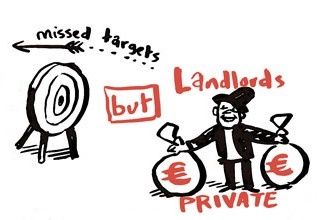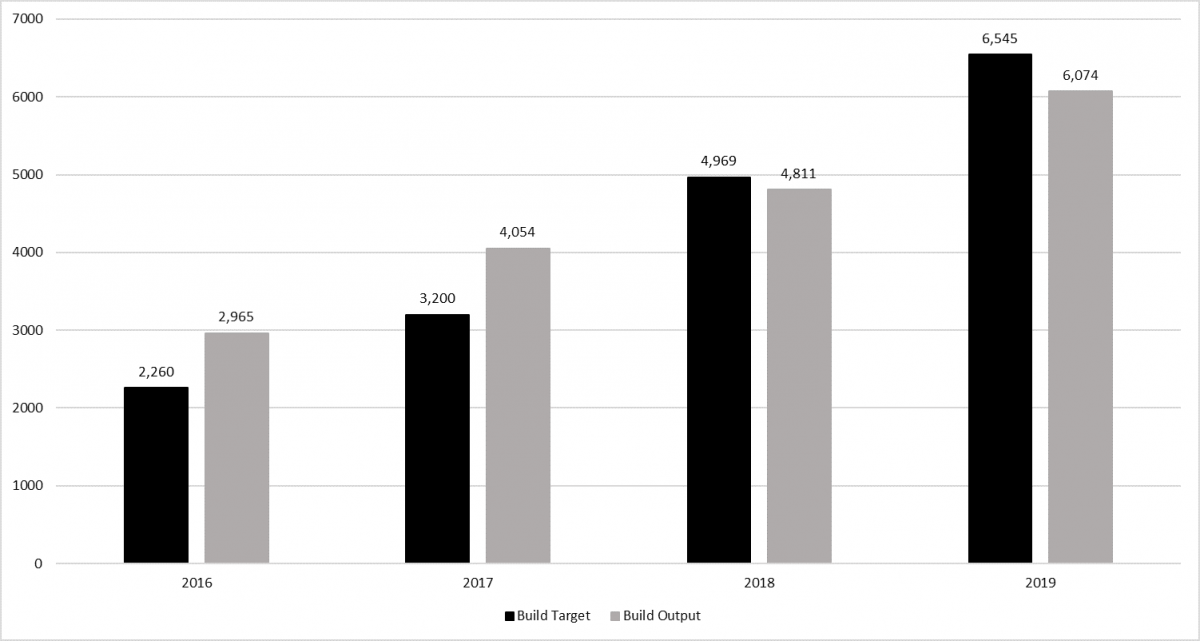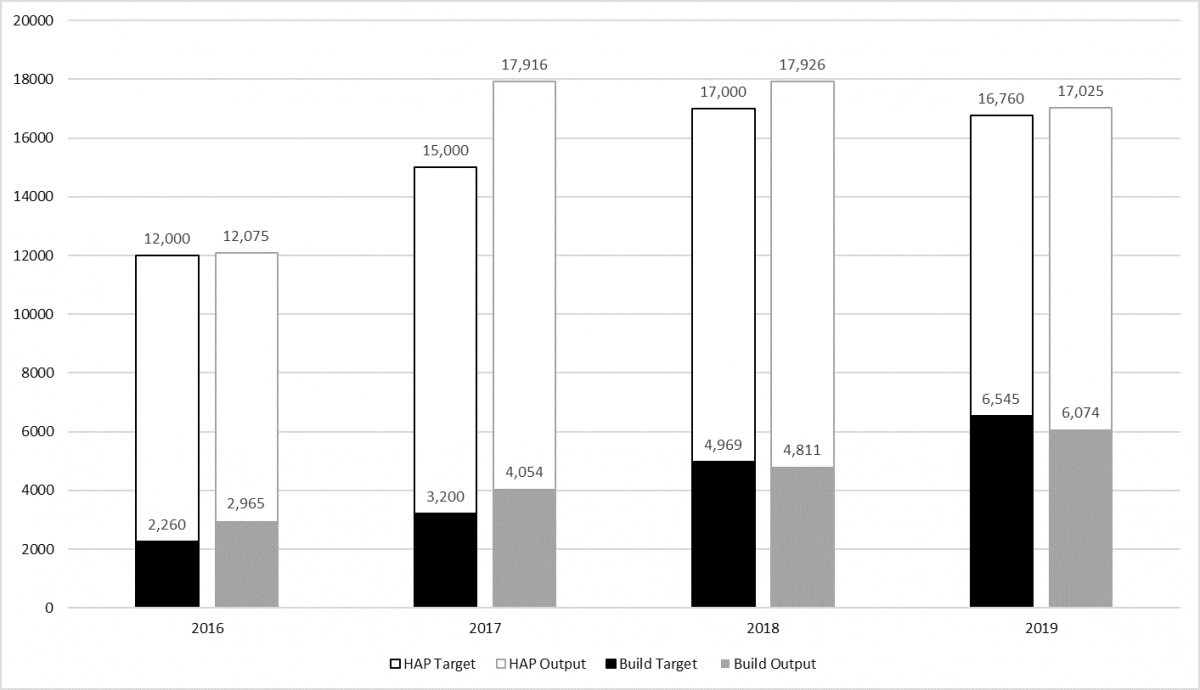Time to set a new Social Housing target

According to the Social Housing Needs Assessments 2019, published in December 2019, there were 68,693 households on the waiting list for social housing, presenting as a decrease of 4.4 per cent on the previous year[1]. However, the truth is that the housing crisis is worsening as Government continues to look to the private sector for solutions. Time to set a new social housing target of 20 per cent of all housing stock.
In 2011, the number of households assessed as having a social housing need was 98,318[2] – the highest number since 1993 (when it was 28,200). A change in the way need was calculated, and a removal of duplicates, saw this number reduce in 2013 to 89,872. The introduction of HAP, and the transfer of households in long-term receipt of Rent Supplement to this payment further reduced these numbers. Households in receipt of HAP are deemed to have their social housing need met and are not counted in the Summary of Social Housing Assessments, the official figure used to determine need. This means that households who would, pre-2014, have been given Rent Supplement and included in the social housing waiting list data, are no longer included. It also means that, notwithstanding the fact that the actual circumstances of those households that were transferred from Rent Supplement to HAP may not have changed, they have been removed from the list.
There has also been some debate surrounding the methodology used by local authorities in collecting information about those still on the housing waiting list, namely an ‘opt in’ letter requesting information on housing status which, if not returned, results in automatic removal from the list. While discretion was given to local authorities to make further contacts by telephone and text message, this method of data collection adversely affects those with low literacy skills and those with reduced capacity to engage in this manner, whether through stress or other socio-economic factors. It therefore risks excluding the most vulnerable households and could be a contributory factor to the rising rate of family homelessness.
Another factor may be that while those in receipt of Rent Supplement are counted, and account for 28.6 per cent of households on the social housing waiting list, those in receipt of the HAP, living in local authority rented accommodation, accommodation under the Rental Accommodation Scheme, accommodation provided under the Social Housing Capital Expenditure Programmes or any households on the transfer list are not counted as in need of social housing assistance. Between 2016 and 2019, 13,256 households were transferred from Rent Supplement to HAP. Rent Supplement transfers accounted for 16.4 per cent of the total number of HAP tenancies created in 2019 and 18.5 per cent of those created in 2018. These are precarious tenancies, left to the exigencies of a private market. While they continue to be omitted from official statistics on housing need, policy in this area will continue to focus on short-term fixes, rather than long-term solutions.
Targets
According to the Rebuilding Ireland Targets and Progress Report, the target to provide 47,000 social housing units has been revised to 50,483 (Pillar 2), of which just 31,238 had been delivered through builds, acquisition and leasing up to the end of 2019. Just 53 per cent of the total build target of 33,617 has been met to the end of 2019 (Chart 1), with targets missed for 2018 and 2019. It is interesting to note that the acquisition target for the whole programme has already been exceeded (the target to 2021 was for the acquisition of 6,830 units, as of the end of 2019, 9,553 units had been acquired). Speed of delivery is likely a contributing factor, however in many areas this would be a more expensive form of housing provision compared to direct builds by Local Authorities and Approved Housing Bodies, particularly if using State lands. The continuing cost to the Exchequer must also be a factor in determining the best method and it is time that a full comparative long-term cost analysis is developed.
Chart 1: Social Housing Builds v Targets, 2016 to 2019

Source: Analysis of Rebuilding Ireland – Targets and Progress, Department of Housing, Planning and Local Government
Recent Government policy has seen a shift away from the construction of social housing to an over-reliance on the private rented sector to provide social housing ‘solutions’. This is evident from both the increase and change in nature of the current expenditure on housing in recent years. According to a report prepared by the Irish Government Economic and Evaluation Service (IGEES) for the Department of Public Expenditure and Reform, from 2006 to 2017 Rent Supplement was the main area of current housing expenditure. While the proportion attributed to the Rental Accommodation Scheme (RAS) was growing steadily during this period, the introduction of the Housing Assistance Payment (HAP) in 2014 has had the greatest impact on the distribution of current housing expenditure[3].
Ostensibly, the introduction of HAP was to provide a longer-term supplementary payment for the growing number of private tenants in receipt of Rent Supplement for longer than its intended duration. Since 2014, the importance of HAP as a means of providing ‘social housing supports’ increased dramatically, and it was the cornerstone of Rebuilding Ireland’s “social housing solutions” (Chart 2).
HAP is a payment made by the local authority directly to the landlord in respect of a household assessed as needing long-term social housing. The tenancy is between the landlord and the tenant, and notwithstanding the introduction of anti-discrimination laws in favour of tenants in receipt of HAP, choosing to accept, and retain, HAP tenants in a time of continued rent inflation remains at the discretion of the landlord.
Chart 2: Social Housing (builds) and HAP, Targets v Output, 2016 to 2019

Source: Analysis of Rebuilding Ireland – Targets and Progress, Department of Housing, Planning and Local Government
The decline in local authority construction, discretionary nature of HAP tenancies, increase in the cost of private rents and the promotion by Government of policies which seek to rely on the private rented sector for the provision of social housing places low-income households in precarious living situations. It is also a considerable cost to the Exchequer, with Local Authority Budgets for 2020 anticipating an expenditure of €667.4 million for the year[4].
Government should aim to emulate our European peers who perform well in terms of social housing provision and social housing stock. Social Justice Ireland proposes that Government set a target of 20 per cent of all housing stock in Ireland to be social housing and substantial progress to this target should be made in a 5-year programme for Government[5]. Progress updates and reports should also be presented annually to the Oireachtas.
[1]https://www.housingagency.ie/news-events/summary-social-housing-assessme...
[2]https://www.housingagency.ie/sites/default/files/53.%20Housing-Needs-Ass...
[3]https://igees.gov.ie/wp-content/uploads/2018/10/SIA-Series-Social-Housin...
[4]www.localauthorityfinances.com
[5] http://www.housingeurope.eu/resource-1323/the-state-of-housing-in-the-eu...